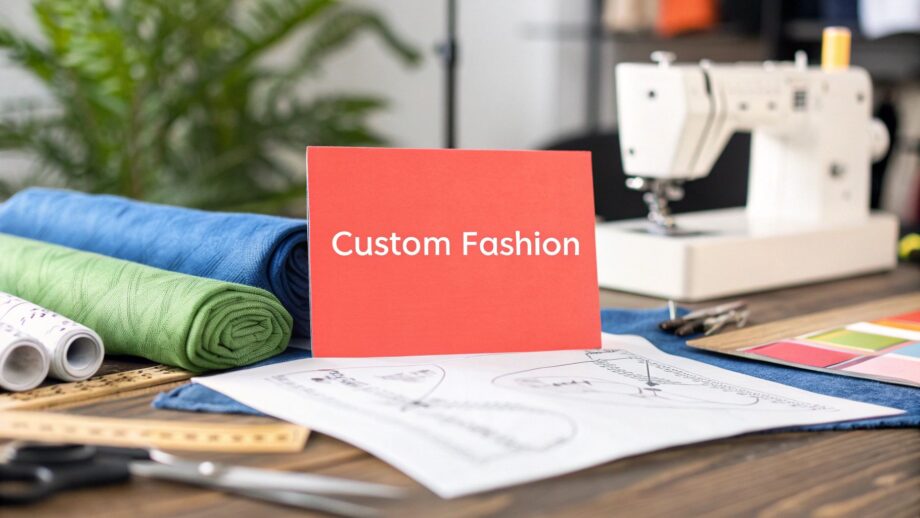Why Making Custom Clothes Is Your Fashion Game-Changer
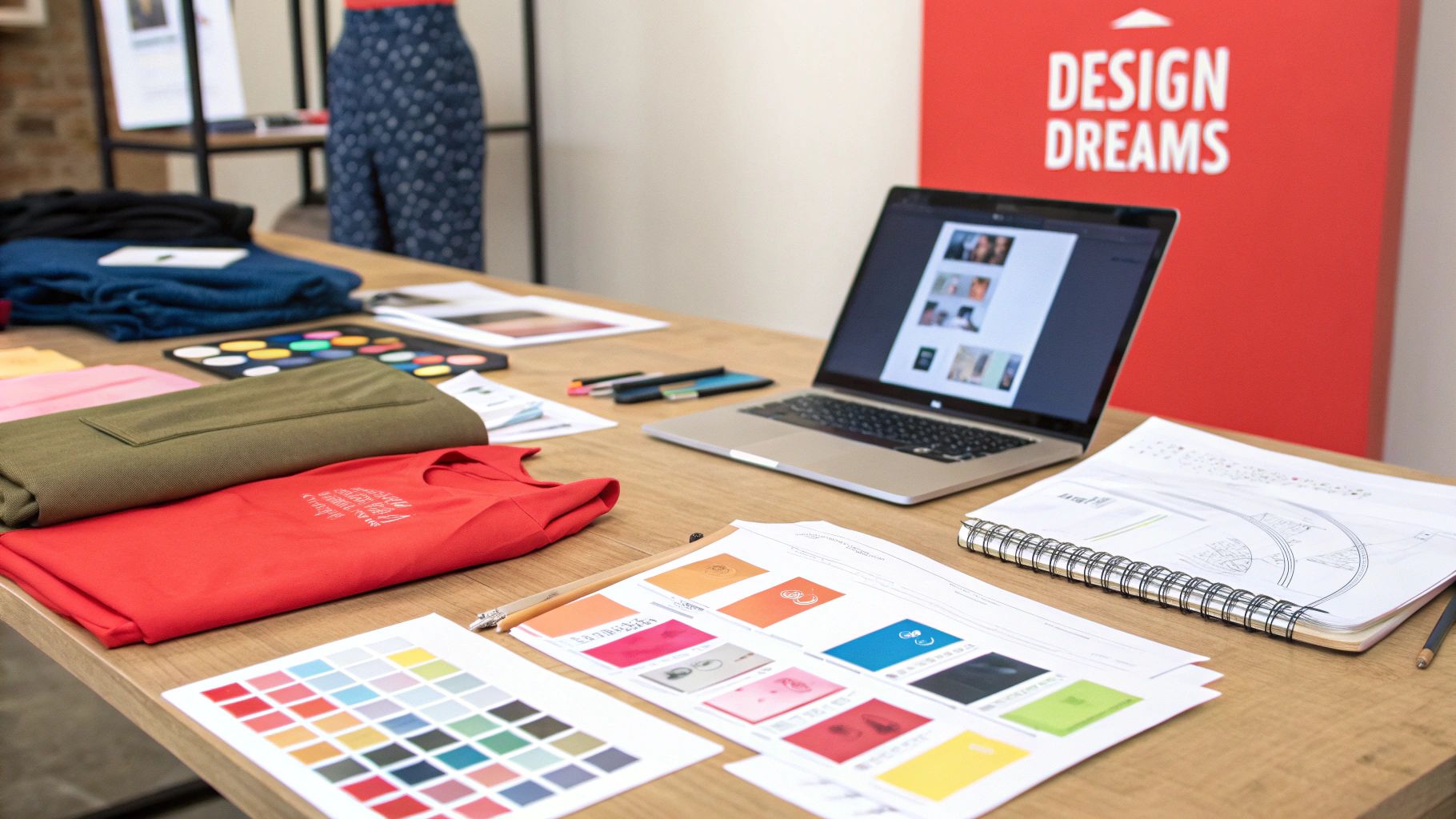
Let's face it: finding that perfect outfit off the rack can be a real struggle. Rarely does it fit perfectly, and it often lacks that special something that truly reflects your personal style. Custom-made clothing offers a refreshing change. It lets you build a wardrobe that not only fits impeccably but also expresses your unique personality. You're no longer limited by the constraints of mass-produced fashion.
The Power of the Perfect Fit
One of the biggest advantages of custom-made clothing is achieving the perfect fit. It's not just about getting the measurements right; it's about understanding your body shape and creating garments that flatter your figure. A well-fitting garment boosts your confidence and ensures incredible comfort.
Imagine a dress that gracefully skims your curves or a suit that accentuates your best features. This level of personalized tailoring elevates your overall appearance. It allows you to move with ease and confidence. This brings us to the equally compelling benefit of personalized style.
Expressing Your Individuality
Custom-made clothing empowers you to express your unique style in ways that mass-produced clothing simply cannot. You have complete control over the design, fabric, and details, ensuring each piece truly reflects you.
You can incorporate elements that resonate with your personality, whether it's a bold print, a vintage-inspired silhouette, or a special embellishment. This freedom of expression allows you to create a wardrobe that genuinely represents who you are. But the benefits extend beyond personal style. Custom clothing also contributes significantly to sustainability.
Embracing Sustainable Fashion
In a world increasingly concerned with the environmental impact of fast fashion, custom-made clothing offers a sustainable solution. By creating pieces designed to last, you reduce textile waste and minimize your environmental footprint.
Choosing high-quality, ethically sourced fabrics lets you support responsible production practices. The growing popularity of custom clothing reflects this shift toward mindful consumption. The global custom-made clothes market, valued at USD 51.89 billion in 2023, is expected to reach USD 131.6 billion by 2031, showing a CAGR of 10.9%. This growth highlights the increasing consumer demand for personalized and sustainable apparel. You can find more detailed statistics here: Verified Market Research. This expanding market also presents exciting opportunities for aspiring entrepreneurs.
The following table summarizes the key benefits of choosing custom-made clothing over mass-produced options:
Benefits of Custom-Made Clothes vs. Mass-Produced Clothing
| Factor | Custom-Made Clothes | Mass-Produced Clothing |
|---|---|---|
| Fit | Perfectly tailored to your body | Generic sizing, may require alterations |
| Style | Reflects individual personality and preferences | Limited options, follows current trends |
| Sustainability | Reduces textile waste, supports ethical production | Contributes to fast fashion, potential for unethical practices |
| Quality | Typically higher quality materials and construction | Often lower quality materials and construction |
| Cost | Generally more expensive | Generally less expensive |
As you can see, while cost might be a factor, the advantages of a perfect fit, expressing your unique style, and supporting sustainable practices often outweigh the price difference.
From Passion to Profit
For many, making custom clothes starts as a creative outlet. This passion, however, can blossom into a successful business. There's a growing demand for authentic, personalized fashion.
This demand creates opportunities for skilled sewists to turn their craft into a profitable venture. Whether it’s a side hustle or a full-fledged business, making custom clothes offers a path to financial independence while pursuing a fulfilling passion.
Essential Tools That Transform Your Custom Clothing Journey
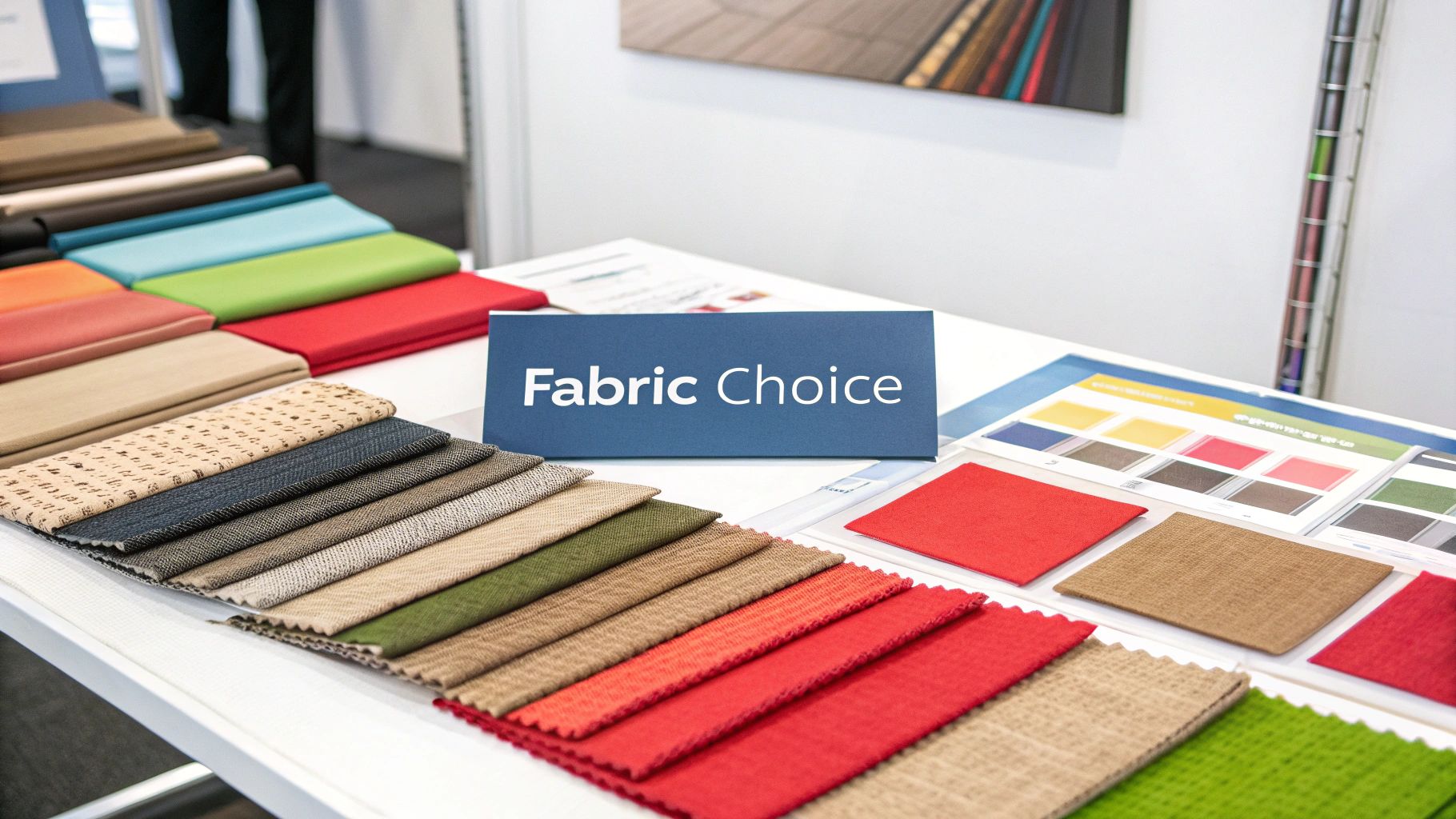
Creating custom clothes is more than just a hobby; it's a journey of self-expression and craftsmanship. Finding the right tools is key to bringing your unique vision to life. Whether you're a beginner or an experienced sewist, the proper equipment can significantly impact the final outcome of your projects.
The Foundation: Must-Have Basics
Every sewing enthusiast needs a core set of tools. These foundational pieces are essential for constructing well-made garments and form the backbone of your sewing kit. Think of them as your trusty companions on your creative journey.
- Sewing Machine: A reliable sewing machine is your primary workhorse. Look for features like adjustable stitch length and width, a variety of stitch types, and a sturdy build. Brother is a popular brand known for its quality machines.
- Sharp Scissors: Dedicated fabric scissors are crucial for maintaining sharpness and ensuring clean cuts, preventing frayed edges. Don't use them for paper!
- Measuring Tape: Accurate measurements are essential in custom clothing. Invest in a high-quality measuring tape that won't stretch or distort over time.
- Pins and Needles: These small but essential tools hold your fabric together during the sewing process. A variety of sizes and types will come in handy for different fabrics and projects.
- Seam Ripper: We all make mistakes! A seam ripper allows you to correct errors without damaging your fabric, saving you from frustration.
These basic tools provide a solid starting point. As your skills grow, you’ll discover new techniques and projects that inspire you to expand your toolkit.
Level Up: Specialty Tools for Elevated Craftsmanship
Once you’ve mastered the basics, specialty tools can truly elevate your custom clothing game. These tools open doors to more intricate designs and professional-looking finishes, taking your creations to the next level.
A rotary cutter and cutting mat, for example, offer incredibly clean, precise cuts, especially beneficial for intricate patterns and multiple layers of fabric. Similarly, a serger creates professional seam finishes and prevents fraying, adding a polished touch to your garments.
Other specialty tools worth considering include:
- Dress Form: A dress form acts as your personal mannequin, allowing you to drape and shape fabric directly on a body double for a perfect fit.
- Tailor's Chalk: Tailor's chalk creates temporary markings on fabric that are easily removed, assisting with pattern placement and alterations.
- Iron and Ironing Board: Pressing your seams as you sew is a crucial step for achieving a professional look. A good iron and ironing board make this process efficient and effective.
Investing in these tools can significantly improve the quality and efficiency of your sewing projects. Learn more in our article about how to master essential sewing techniques. With the right tools and knowledge, you can create custom garments that rival professionally made pieces. Ultimately, your tool selection will depend on your individual needs and project complexity.
Designing Your Dream Garments: From Inspiration to Pattern
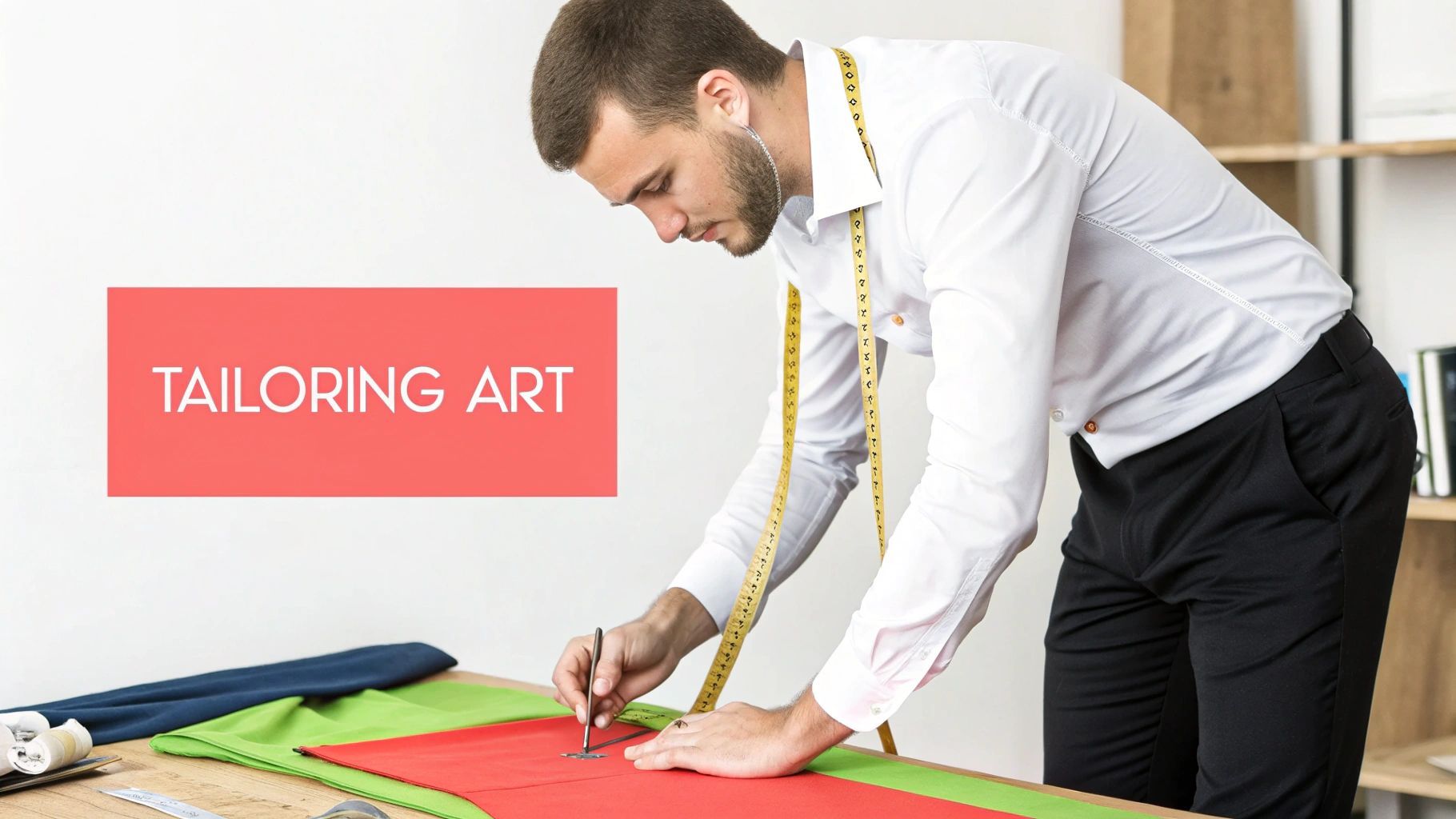
Tired of searching for clothes that just don't exist? Learn to make custom clothes that perfectly capture your style. This section breaks down the design process, making it easy for everyone, from sewing newbies to seasoned stitchers. We'll explore different ways to develop patterns, giving you the skills to create truly one-of-a-kind garments.
Unlocking Your Creative Potential: Finding Inspiration
The journey to custom-made clothing starts with inspiration. This could be anything from a vintage photo, a captivating piece of artwork, or even a fascinating texture you see in your daily life. Think about the intricate details of a flower, which could inspire an embroidered pattern for a blouse.
Keeping an eye on current fashion trends can also spark new ideas, allowing you to add your own personal touch. Finding that unique spark of inspiration is the first step towards creating a truly personalized garment.
From Inspiration to Reality: Pattern Development Approaches
Once you're inspired, the next step is turning that inspiration into a pattern. There are several ways to develop patterns, each with its own benefits. You can adapt existing patterns, changing the fit, shape, or adding special design elements. This is a great place to start for beginners.
You can also draft patterns from scratch using your measurements and drafting techniques. This gives you complete control over the final piece. Each approach brings a different level of detail to the process of making custom clothes.
-
Modifying Existing Patterns: This involves taking a commercial pattern and making it your own. You can adjust the sleeve length, change necklines, or even mix and match elements from several different patterns.
-
Drafting from Scratch: This method requires understanding body measurements and how they become two-dimensional pattern pieces. It allows for complete customization and is perfect for unique designs.
-
Draping: Draping involves shaping fabric directly on a dress form to create the desired look. This hands-on approach is often used for more complex designs.
-
Digital Pattern Making: Digital tools and software like Adobe Illustrator make pattern creation faster, allowing for easy adjustments and precise results.
Measurements and Tweaks: The Key to a Flattering Fit
Accurate measurements are crucial for well-fitting custom clothing. Taking precise body measurements ensures a garment that fits properly and flatters your body shape. For instance, understanding how to measure your bust, waist, and hips correctly is the base for a well-fitting bodice.
But just having the right numbers isn't enough. Small tweaks during the pattern-making process can make a big difference in how the final garment fits and looks. This attention to detail transforms a homemade item into a handcrafted masterpiece. It also means understanding ease, the extra room added to a pattern for comfort and movement.
The custom apparel market is booming, expected to grow by USD 2.45 billion between 2025 and 2029, driven by the growing interest in personalized fashion. More detailed statistics can be found here: Custom Apparel Market Analysis. This growth reflects the increasing demand for unique, made-to-order clothing and the desire for individual expression through style. By mastering these techniques, you gain control over fit, style, and the confidence that comes from wearing clothes designed just for you.
Bringing Your Custom Clothes to Life: Hands-On Techniques
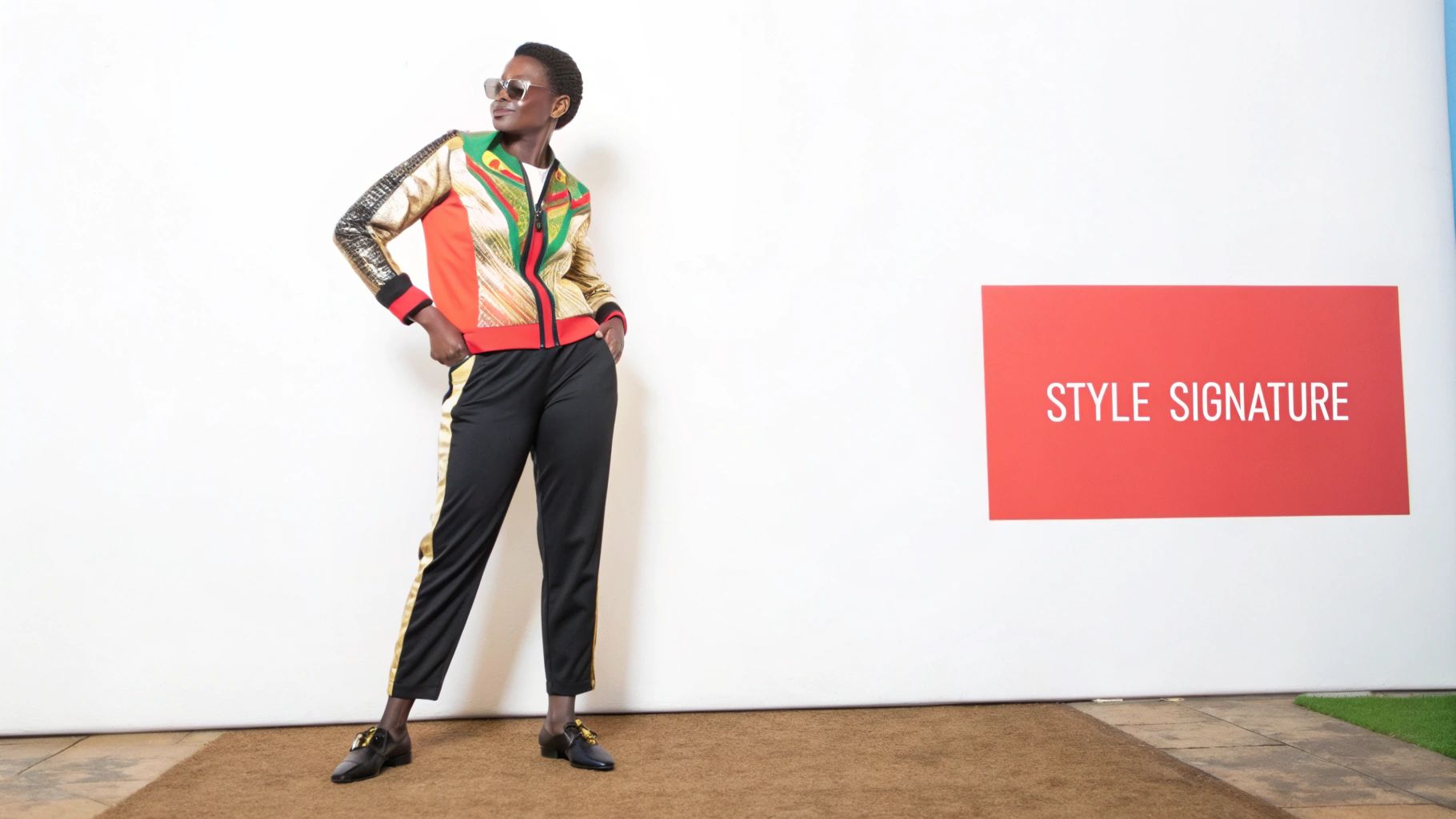
Now that your design and pattern are finalized, the truly exciting part begins: construction! This is where you transform flat fabric into a three-dimensional garment. This section will be your guide to the essential techniques for creating custom clothes with a professional look. We'll cover every step, from preparing your fabric to adding those final, polished touches.
Preparing Your Fabric: The Foundation of a Quality Garment
Just as an artist prepares their canvas, preparing your fabric is crucial. Pre-washing is essential to prevent shrinkage and color bleeding after the garment is complete. This is especially important for natural fibers like cotton and linen.
Ironing your fabric is another key step. It removes wrinkles and ensures accurate cutting and sewing, making the entire construction process smoother. This attention to detail is what sets apart professional results.
Mastering Essential Sewing Techniques
With your fabric prepared, it's time to start sewing. Understanding basic sewing techniques is the key to constructing a variety of garments.
- Straight Stitch: This foundational stitch is used for seams, topstitching, and much more.
- Zigzag Stitch: The zigzag stitch is essential for finishing raw edges, adding decorative flair, and working with stretchy materials.
- Backstitch: Use backstitching to secure seams at the beginning and end, preventing them from unraveling.
- Gathering: This technique adds fullness and volume, commonly used in skirts and sleeves.
These are just a few examples. Mastering them will give you the confidence to tackle numerous projects. For more in-depth information, explore additional resources online.
Specialized Approaches for Challenging Fabrics
Certain fabrics present unique challenges due to their properties, requiring specific techniques. For example, silk is delicate and prone to fraying, demanding careful handling and sharp tools. Denim, conversely, requires heavy-duty needles and strong thread due to its sturdy nature.
Stretch fabrics also need special attention. Specialized needles and stitches are essential to allow seams to stretch without breaking. Understanding these nuances expands your creative possibilities, allowing you to work with a diverse range of materials.
To help you navigate these various techniques and fabric considerations, the following table provides a helpful guide:
Essential Sewing Techniques for Different Garment Types: A comprehensive guide to specific sewing techniques required for different types of custom clothing items
| Garment Type | Key Techniques | Difficulty Level | Special Considerations |
|---|---|---|---|
| Silk Dress | French seams, delicate hand stitching | Intermediate | Use fine needles and silk thread. Avoid pulling or stretching the fabric. |
| Denim Jeans | Flat-felled seams, topstitching | Intermediate | Use heavy-duty needles and strong thread. Reinforce stress points. |
| Stretch Knit Top | Zigzag stitch, twin needle stitching | Beginner | Use ballpoint needles and stretch thread. Test stitch on scrap fabric. |
| Cotton T-shirt | Straight stitch, bias binding | Beginner | Pre-wash fabric to prevent shrinkage. Use a medium-weight needle and thread. |
This table summarizes the key techniques and considerations for various garment types. Experimenting with different fabrics and techniques will enhance your sewing skills.
From Amateur to Professional: The Secret Details
Small details often distinguish homemade garments from professional ones. These details might seem insignificant individually, but collectively elevate the overall quality.
Clipping curves and corners, for example, allows seams to lie flat, especially important in curved areas. Pressing seams open as you sew also creates a crisper, more professional finish. These small techniques make a noticeable difference.
Troubleshooting and Time-Saving Tips
Even experienced sewists run into challenges. Learning to recognize common construction issues, like puckered seams or uneven hems, and knowing how to fix them will save you time and frustration.
Time-saving techniques are also valuable. Using pattern weights instead of pins can speed up the cutting process. A walking foot attachment for your sewing machine can prevent layers of fabric from shifting, especially helpful with thicker materials.
Finishing Touches: Elevating Your Custom Creations
The final step is adding finishing touches that give your garments a polished look. This could include adding buttons, zippers, or other closures.
Topstitching adds a decorative element while reinforcing seams for a professional touch. Paying attention to these small details transforms a simple garment into a stylish, well-crafted piece. By learning these techniques and embracing attention to detail, you can bring your custom clothing visions to life.
Transform Existing Clothes Into Custom Treasures
That dream wardrobe you've always wanted? It might be closer than you think. It could be hiding in your existing closet or waiting to be unearthed at your local thrift store. Instead of always buying new clothes, try transforming what you already own into custom pieces. This not only gives new life to older items but also creates a more sustainable approach to fashion.
Reimagine, Repurpose, Recreate: Giving New Life to Old Clothes
Transforming your existing clothes is all about refashioning. This means taking those older garments and reworking them into something fresh and exciting. Imagine turning a pair of outdated jeans into a chic denim skirt. Or maybe an oversized men's shirt becomes a trendy, fitted blouse. Refashioning lets you create unique pieces that truly reflect your personal style.
Practical Alterations: Perfecting the Fit
Sometimes a garment just needs a little tweaking to fit perfectly. Altering clothes is a key part of creating a custom wardrobe. Hemming pants, taking in a dress at the waist, or adjusting the straps on a top can make a huge difference. These small changes can transform an ill-fitting piece into a favorite go-to item. This can also be much more affordable than buying new, perfectly tailored clothing.
Creative Embellishments: Adding Visual Interest
Embellishments offer so many ways to personalize your clothes. Adding decorative elements like embroidery, patches, beads, or appliqués can transform a plain garment into a real statement piece. This lets you express your creativity and add unique details to your wardrobe. You're no longer limited to what retailers offer.
Structural Modifications: Reimagining the Garment’s Purpose
Sometimes a more dramatic change is needed. Structural modifications involve altering the fundamental design of a garment. This might mean shortening a dress into a top, combining two separate pieces into one, or even turning a t-shirt into a tote bag. These transformations require a bit more sewing know-how, but they offer a chance to completely reinvent a garment's function.
Identifying Transformation Potential: Finding the Hidden Gems
Not every piece of clothing is suitable for refashioning. Look for items made of high-quality fabrics in good condition when selecting garments to transform. Consider the garment's construction and silhouette. Simple garments with classic lines are usually the most versatile. You might be interested in learning how to master essential sewing techniques to work with these materials.
The custom clothing market is also experiencing significant growth, with regional differences impacting its direction. In Europe, custom clothing holds a notable market share, exceeding 30% globally. The Asia Pacific region is expected to grow at a CAGR of 11.8% between 2024 and 2031. This expansion is driven by increased disposable incomes and a growing demand for personalized, sustainable fashion, especially among women. Learn more about the custom clothing market from Cognitive Market Research. By learning to identify these hidden gems in your own closet, you can open up a world of creative possibilities and build a wardrobe filled with unique, custom-made pieces.
Building Your Custom Wardrobe With Purpose and Impact
Moving beyond individual sewing projects to a cohesive, custom-made wardrobe takes planning and intention. It’s about building a collection of garments that fit you perfectly, express your style, and reflect your values. This transforms your relationship with fashion, making it more sustainable and personally rewarding. You might be interested in: How to master planning techniques to map your ideal custom wardrobe.
Sustainable Choices: Fabrics and Techniques
Building a sustainable wardrobe begins with choosing the right materials. Seek out eco-friendly fabrics like organic cotton, linen, Tencel, or recycled materials. These options lessen your environmental footprint and often provide superior comfort and durability.
Consider zero-waste cutting techniques, too. These methods minimize fabric scraps and textile waste. It requires a bit more planning but significantly contributes to a more sustainable sewing practice.
Designing for Versatility: Maximizing Wear
When creating custom clothes, design pieces you can mix and match. This modular wardrobe approach maximizes the number of outfits you can create with fewer garments. It reduces the need for a large, ever-changing closet.
For example, a well-tailored blazer can be dressed up with a custom-made skirt for a formal event or paired with jeans and a t-shirt for a casual look. This versatility is key to a functional and sustainable wardrobe.
The Power of Planning: Color Palettes and Silhouettes
A well-planned color palette is essential for a cohesive wardrobe. Choosing a core group of complementary colors allows for effortless mixing and matching, maximizing outfit options. This thoughtful approach simplifies getting dressed each day and reduces impulse buys.
Think about the silhouettes you prefer and how they complement your body shape. Custom clothing allows you to create garments that flatter your figure and truly express your personal style, eliminating the frustration of searching for clothes that fit and look good.
Maintaining Your Investment: Extending Garment Lifespan
Proper care extends the life of your custom-made clothes, maximizing your investment and reducing textile waste. Learning basic garment repair, like mending seams and replacing buttons, keeps your clothes in great shape for longer.
Storing your clothes properly, whether folded or hung, prevents damage and helps them retain their shape. These simple habits ensure your custom-made wardrobe remains a stylish and satisfying source of clothing for years to come.
Stories of Success: Reduced Consumption, Increased Style
Many sewists have successfully decreased their fashion consumption by embracing custom clothing. They've found that a smaller, curated wardrobe of high-quality, custom-made pieces brings greater style satisfaction than constantly chasing trends.
These stories show that meaningful fashion independence is possible. By investing time and effort in making custom clothes, you gain control over your wardrobe and develop a deeper appreciation for what you wear.
Want to create unforgettable, custom-designed gifts? ThisShirtExists.com uses AI to turn your wildest ideas into wearable art. Design your own masterpiece today!

